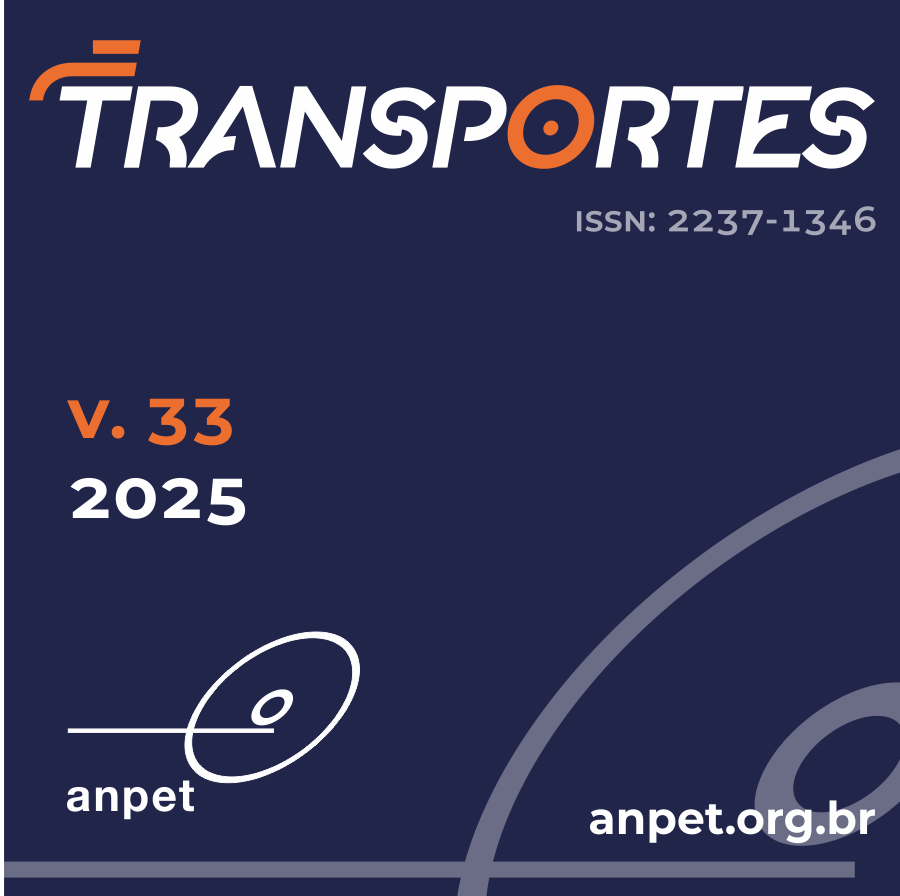Circularity and carbon footprint: environmental performance of road rehabilitation solution with recycled materials
DOI:
https://doi.org/10.58922/transportes.v33.e3104Keywords:
Life cycle assessment. Cold recycled asphalt mixture. Pavement rehabilitation. Sustainability.Abstract
The use of reclaimed asphalt pavement (RAP) for highway pavements rehabilitation has been growing in view of the need to reduce waste, by reusing it, and enhance the circularity of civil construction. However, the use of RAP needs to be evaluated in terms of carbon footprint in pavements. The objective of this study is to evaluate the potential environmental benefit of restoration solution with RAP cold recycled with asphalt emulsion, compared to restoration with virgin materials only. The indicators of material and water consumption, solid waste generation and carbon footprint were analyzed. The results indicate that the structure with cold recycled material has better circularity indicators in terms of material consumption and waste generation, but it may have a higher carbon footprint than the conventional flexible structure. However, the pavement responses differ significantly, with a potential difference in durability between the structures. In this respect, the recycled pavement structure may have environmental benefits.
Downloads
References
ABNT (2023) NBR ISO 14067 - Gases de efeito estufa - Pegada de carbono de produtos - Requisitos e orientações sobre quantificação. Rio de Janeiro: ABNT.
Amarh, E.A.; J. Santos; G.W. Flintsch et al. (2022) Evaluating the potential environmental benefits of cold recycling-based methods for flexible pavement rehabilitation in Virginia. Transportation Research Record: Journal of the Transportation Research Board, v. 2676, n. 6, p. 75-86. DOI: 10.1177/03611981211072786. DOI: https://doi.org/10.1177/03611981211072786
Belizario-Silva, F. (2022) Proposal of life cycle-based environmental performance indicators for decision-making in construction. Tese (doutorado). Universidade de São Paulo. São Paulo. DOI: 10.11606/T.3.2022.tde-31102022-091740. DOI: https://doi.org/10.11606/T.3.2022.tde-31102022-091740
Bowers, B.F.; B.K. Diefenderfer; S.A. Cross et al. (2023) Construction Guidelines for Cold Central Plant Recycling and Cold In-Place Recycling (No. NCHRP Project 14-43). Washington: National Academies of Sciences, Engineering, and Medicine. DOI: https://doi.org/10.17226/26939
Brasil, Agência Nacional de Petróleo, Gás Natural e Biocombustíveis (2008) Resolução No 39 da ANP. Diário Oficial da República Federativa do Brasil, Brasília.
Brondani, C. (2023) Comportamento mecânico de misturas asfálticas recicladas a frio com emulsão e cimento portland. Tese (doutorado). Universidade Federal de Santa Maria. Santa Maria. Disponível em: <http://repositorio.ufsm.br/handle/1/30523> (acesso em 14/08/2025).
Diefenderfer, B.K.; G. Flintsch; W. Xue et al. (2023) Structural performance of an asphalt pavement containing cold central plant recycling and full-depth reclamation. Transportation Research Record: Journal of the Transportation Research Board, v. 2677, n. 1, p. 409-19. DOI: 10.1177/03611981221099511. DOI: https://doi.org/10.1177/03611981221099511
EAPA. (2021) Asphalt in Figures 2020. European Asphalt Pavement Association. Disponível em: <https://eapa.org/asphalt-in-figures-archive/?utm_source=SOME&utm_medium=EAPA&utm_campaign=MARCH> (acesso em 20/10/2024).
Ebels, L.J. (2008) Characterisation of material properties and behaviour of cold bituminous mixtures for road pavements. Tese (doutorado). University of Stellenbosch. Stellenbosch. Disponível em: <https://core.ac.uk/download/pdf/37319064.pdf> (acesso em 14/08/2025).
Ghasemi, P.; M. Aslani; D.K. Rollins et al. (2018) Modeling rutting susceptibility of asphalt pavement using principal component pseudo inputs in regression and neural networks. International Journal of Pavement Research and Technology, v. 11, n. 6, p. 679-88. DOI: 10.1016/j.ijprt.2018.01.003. DOI: https://doi.org/10.1016/j.ijprt.2018.01.003
Gu, F.; W. Ma; R.C. West et al. (2019) Structural performance and sustainability assessment of cold central-plant and in-place recycled asphalt pavements: a case study. Journal of Cleaner Production, v. 208, p. 1513-23. DOI: 10.1016/j.jclepro.2018.10.222. DOI: https://doi.org/10.1016/j.jclepro.2018.10.222
Guatimosim, F.V.; K.L. Vasconcelos; L.L.B. Bernucci et al. (2018) Laboratory and field evaluation of cold recycling mixture with foamed asphalt. Road Materials and Pavement Design, v. 19, n. 2, p. 385-99. DOI: 10.1080/14680629.2016.1261726. DOI: https://doi.org/10.1080/14680629.2016.1261726
Huang, Y.; R.N. Bird e O. Heidrich (2007) A review of the use of recycled solid waste materials in asphalt pavements. Resources, Conservation and Recycling, v. 52, n. 1, p. 58-73. DOI: 10.1016/j.resconrec.2007.02.002. DOI: https://doi.org/10.1016/j.resconrec.2007.02.002
IPCC (2021) Climate Change 2021: The Physical Science Basis. In Masson-Delmotte, V.; P. Zhai; A. Pirani et al. (eds.) Contribution of Working Group I to the Sixth Assessment Report of the Intergovernmental Panel on Climate Change. Cambridge: Cambridge University Press.
IPCC (2022) Climate Change 2022: Mitigation of Climate Change. In Shukla, P. R.; J. Skea; R. Slade et al. (eds.) Contribution of Working Group III to the Sixth Assessment Report of the Intergovernmental Panel on Climate Change. Cambridge: Cambridge University Press. DOI: 10.1017/9781009157926. DOI: https://doi.org/10.1017/9781009157926
Kuchiishi, A.K.; K. Vasconcelos e L.L.B. Bernucci (2021) Effect of mixture composition on the mechanical behaviour of cold recycled asphalt mixtures. The International Journal of Pavement Engineering, v. 22, n. 8, p. 984-94. DOI: 10.1080/10298436.2019.1655564. DOI: https://doi.org/10.1080/10298436.2019.1655564
Leendertse, W.L.; M.E.M. Schäffner and S. Kerkhofs (2018) Introducing the circular economy in road construction. In Caspeele, R.; L. Taerwe and D. Frangopol (eds.) Life Cycle Analysis and Assessment in Civil Engineering: Towards an Integrated Vision. Boca Raton: CRC Press, p. 1639-1644.
Leite, L.M.F.; L.M.G. Motta; E.C. Costa et al. (2021) Informações básicas sobre materiais asfálticos: A importância das características dos agregados no desempenho das misturas asfálticas. Rio de Janeiro: Instituto Brasileiro de Petróleo e Gás. Disponível em: <https://www.ibp.org.br/personalizado/uploads/2021/05/2021-ebook-ibp-informacoes-basicas-sobre-materiais-asfalticos.pdf> (acesso em 14/08/2025).
Lopes, A. F. D.; K. Vasconcelos; M. S. S. Almeida et al. (2024) Geração e utilização do rap no Brasil. Revista ENINFRA, v. 3, n. 3, p. 201-217. DOI: https://doi.org/10.70859/2764-9539.v3.n3.126
Lynch, A.G. (2013) Trends in back-calculated stiffness of in-situ recycled and stabilised road pavement materials. Tese (doutorado). University of Stellenbosch. Stellenbosch. Disponível em: <https://loudoninternational.co.za/wp-content/uploads/2021/10/Lynch_Alan-Masters-trend_2013_17-Nov-2013-Rev2.pdf> (acesso em 14/08/2025).
Mantalovas, K.; G. Di Mino; A.J.B. Carrion et al. (2020) European national road authorities and circular economy: An insight into their approaches. Sustainability, v. 12, n. 17, p. 7160. DOI: 10.3390/su12177160. DOI: https://doi.org/10.3390/su12177160
Meneses, J.P.C.; K. Vasconcelos e L.L.B. Bernucci (2022) Stiffness assessment of cold recycled asphalt mixtures: Aspects related to filler type, stress state, viscoelasticity, and suction. Construction & Building Materials, v. 318, p. 126003. DOI: 10.1016/j.conbuildmat.2021.126003. DOI: https://doi.org/10.1016/j.conbuildmat.2021.126003
Moins, B. (2024) Sustainability assessment of roads containing reclaimed asphalt pavement (RAP): decision support based on LCA & LCCA during road design. Tese (doutorado). University of Antwerp. Antwerp. DOI: 10.63028/10067/2067820151162165141. DOI: https://doi.org/10.63028/10067/2067820151162165141
Pasche, E.; C.F.C.E. Silva; G.M. Pires et al. (2014) Study of the RAP characteristics and its applications to pavement layers in southern Brazil. Proceedings of the 21st Asphalt Meeting, v. 1, p. 1-12.
PMSP (2004) IP - 08/2004: Análise Mecanicista à Fadiga de Estruturas de Pavimento. São Paulo: PMSP/SIURB.
Revista OE (2025) Estudo reaproveita 100% material fresado e reduz emissões., Revista O Empreitero, 26 de maIO.
Tanski, M.; L.P. Specht; T.C. Cervo et al. (2017) Análise de misturas asfálticas recicladas a frio para emprego em canadas de base e sub base de pavimentos. Revista Estradas, v. 1, p. 66-73.
Tushar, Q.; J. Santos; G. Zhang et al. (2022) Recycling waste vehicle tyres into crumb rubber and the transition to renewable energy sources: A comprehensive life cycle assessment. Journal of Environmental Management, v. 323, p. 116289. DOI: 10.1016/j.jenvman.2022.116289. PMid:36261991. DOI: https://doi.org/10.1016/j.jenvman.2022.116289
Unger-Filho, W.; L.M. Gutiérrez Klinsky; R. Motta et al. (2020) Cold recycled asphalt mixture using 100% RAP with emulsified asphalt-recycling agent as a new pavement base course. Advances in Materials Science and Engineering, v. 2020, p. 1-11. DOI: 10.1155/2020/5863458. DOI: https://doi.org/10.1155/2020/5863458
Vieira, L.B.P.; A.D. Figueiredo e V.M. John (2020) Evaluation of the use of crushed returned concrete as recycled aggregate in ready-mix concrete plant. Journal of Building Engineering, v. 31, p. 101408. DOI: 10.1016/j.jobe.2020.101408. DOI: https://doi.org/10.1016/j.jobe.2020.101408
Watson, R.; B. Abbassi e Z.S. Abu-Hamatteh (2020) Life cycle analysis of concrete and asphalt used in road pavements. Environmental Engineering Research, v. 25, n. 1, p. 52-61. DOI: 10.4491/eer.2018.399. DOI: https://doi.org/10.4491/eer.2018.399
Zhou, Q.; I. Al-Qadi; H. Ozer et al. (2020) Pavement recycling: a case study of life-cycle assessment and life-cycle cost analysis. In International Symposium on Pavement, Roadway, and Bridge Life Cycle Assessment 2020 (Davis, CA). Boca Raton: CRC Press, p. 404-411. DOI: 10.1201/9781003092278-42. DOI: https://doi.org/10.1201/9781003092278-42
Downloads
Published
How to Cite
Issue
Section
License
Copyright (c) 2025 Zila Maria Garcia Mascarenhas, Fernanda Belizario-Silva, Mariana Bosso, Celso Luiz dos Santos Romeiro Junior, Liedi Légi Bariani Bernucci, Kamilla Vasconcelos

This work is licensed under a Creative Commons Attribution 4.0 International License.
Authors who submit papers for publication by TRANSPORTES agree to the following terms:
- The authors retain the copyright and grant Transportes the right of first publication of the manuscript, without any financial charge, and waive any other remuneration for its publication by ANPET.
- Upon publication by Transportes, the manuscript is automatically licensed under the Creative Commons License CC BY 4.0 license. This license permits the work to be shared with proper attribution to the authors and its original publication in this journal.
- Authors are authorized to enter into additional separate contracts for the non-exclusive distribution of the version of the manuscript published in this journal (e.g., publishing in an institutional repository or as a book chapter), with recognition of the initial publication in this journal, provided that such a contract does not imply an endorsement of the content of the manuscript or the new medium by ANPET.
- Authors are permitted and encouraged to publish and distribute their work online (e.g., in institutional repositories or on their personal websites) after the editorial process is complete. As Transportes provides open access to all published issues, authors are encouraged to use links to the DOI of their article in these cases.
- Authors guarantee that they have obtained the necessary authorization from their employers for the transfer of rights under this agreement, if these employers hold any copyright over the manuscript. Additionally, authors assume all responsibility for any copyright infringements by these employers, releasing ANPET and Transportes from any responsibility in this regard.
- Authors assume full responsibility for the content of the manuscript, including the necessary and appropriate authorizations for the disclosure of collected data and obtained results, releasing ANPET and Transportes from any responsibility in this regard.










